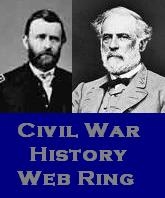We got some outstanding, flash-free photos that capture some of the thrill of seeing these items, and I'd like to start with this letter from President Lincoln to Lt. Gen Ulysses S. Grant written on April 30th, 1864.
 Here is the transcript:
Here is the transcript:Executive Mansion
Washington, April 30. 1864
Not expecting to see you again before the Spring campaign opens, I wish to express in this way, my entire satisfaction with what you have done up to this time, so far as I understand it. The particulars of your plans I neither know or seek to know. You are vigilant and self-reliant; and, pleased with this, I wish not to obtrude any constraints or restraints upon you. While I am very anxious that any great disaster, or the capture of our men in great numbers, shall be avoided, I know these points are less likely to escape your attention than they would be mine -- If there is anything wanting which is within my power to give, do not fail to let me know it.Washington, April 30. 1864
Lieutenant General Grant
And now with a brave army, and a just cause, may God sustain you.
Yours very truly
A. Lincoln
First, let's take a look at Lincoln's handwriting her, because it really captures the story here. You'll note the deliberate, clear hand applied, the even lines, and the sharp margins. This is not the standard in Lincoln's writing; indeed, most items I've seen (and will show you over the next few days) have a much more variegated and rushed appearance. I'm no handwriting expert, but we all know how our writing can vary depending on the context, which begs the question...
On April 3oth, 1864, Lincoln, his administration, and the entire Northern war effort were at a momentous point. The long-planned thrusts into the South in both the Eastern and Western theaters, with newly appointed Lt. Gen Grant in overall command but following the Army of the Potomac into Virginia, were about to be launched. It was an election year, and with three years of bloody war gone by with no end in sight, there was real concern that the Lincoln administration and the war effort were nearly spent.
Lincoln knew what he had in Grant; indeed had known since 1862 when Grant surged onto the national scene. The two men had met in Washington DC in mid-March 1864, a few weeks before this letter was written, when Grant had been given overall command of the Union Army. Grant had earned Lincoln's respect as well as the clear autonomy spelled out in the letter, but with that came the tremendous expectations that underscore every single word Lincoln wrote.
The timing and expectations that traveled with this letter to Grant's camp were of course not lost on Lincoln. He possessed a keen sense of history and his place in it, indeed he facilitated this by the use of his personal secretaries, and he knew that this type of letter would become a touchstone for the moment it was written.
Bringing these considerations into the fold, we can see a meticulously written note, likely the final of several drafts, with each word selected for the moment and crafted with the very best penmanship. General Grant was about to carry the spearpoint of the Union army into the heart of the Confederacy, and with this letter, Lincoln not only sent him on his way, but captured the profound anxiety, courage, and diligence that history requires of its touchstone moments.
A. Lincoln
First, let's take a look at Lincoln's handwriting her, because it really captures the story here. You'll note the deliberate, clear hand applied, the even lines, and the sharp margins. This is not the standard in Lincoln's writing; indeed, most items I've seen (and will show you over the next few days) have a much more variegated and rushed appearance. I'm no handwriting expert, but we all know how our writing can vary depending on the context, which begs the question...
On April 3oth, 1864, Lincoln, his administration, and the entire Northern war effort were at a momentous point. The long-planned thrusts into the South in both the Eastern and Western theaters, with newly appointed Lt. Gen Grant in overall command but following the Army of the Potomac into Virginia, were about to be launched. It was an election year, and with three years of bloody war gone by with no end in sight, there was real concern that the Lincoln administration and the war effort were nearly spent.
Lincoln knew what he had in Grant; indeed had known since 1862 when Grant surged onto the national scene. The two men had met in Washington DC in mid-March 1864, a few weeks before this letter was written, when Grant had been given overall command of the Union Army. Grant had earned Lincoln's respect as well as the clear autonomy spelled out in the letter, but with that came the tremendous expectations that underscore every single word Lincoln wrote.
The timing and expectations that traveled with this letter to Grant's camp were of course not lost on Lincoln. He possessed a keen sense of history and his place in it, indeed he facilitated this by the use of his personal secretaries, and he knew that this type of letter would become a touchstone for the moment it was written.
Bringing these considerations into the fold, we can see a meticulously written note, likely the final of several drafts, with each word selected for the moment and crafted with the very best penmanship. General Grant was about to carry the spearpoint of the Union army into the heart of the Confederacy, and with this letter, Lincoln not only sent him on his way, but captured the profound anxiety, courage, and diligence that history requires of its touchstone moments.





